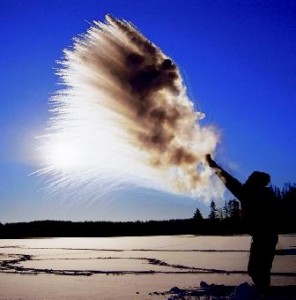 For a good chunk of North America right now…it’s pretty damn cold. Winter has come with a vengence so far for most of North America and for many people it has meant everything from tragic and catastrophic ice storms, huge snowfalls and general unpleasantry.
For a good chunk of North America right now…it’s pretty damn cold. Winter has come with a vengence so far for most of North America and for many people it has meant everything from tragic and catastrophic ice storms, huge snowfalls and general unpleasantry.
Being ever the optimist, I decided that there is also the opportunity for fun and learning so last night as the temperature outside my home just east of Toronto, ON dipped down to about -20 Degrees Celcius (-3 F), I gathered my kids and told them we were going to run a science experiment.
Over the years I’ve occasionally seen demonstrations of how hot water can evaporate when thrown into very cold and dry air. I had never tried it before myself but thought it would be as good a time as any. So I boiled some water into a kettle, grabbed my video camera and the kids, then headed outside to see what would happen.
The results were kinda epic…

I actually first posted this video on my facebook profile and the feedback was fast and furious. It’s been about 14 hours since I posted it to facebook and it has already been shared about 100 times.
SO WHAT’S THE SCIENTIFIC EXPLANATION BEHIND THIS? I was curious myself so I searched online and found a variety of explanations, the best of which came from a website called The Why Files. I’ve basically copied their answer below:
Evaporation plays a key role in this fun phenomenon. Evaporation is the transition of water from the liquid phase to the gas phase. The rate of evaporation depends on the temperature difference between the water and the air, and evaporation is more rapid in low humidity. Hot water is closer than cold water to evaporating, so your cup of near-boiling water is already close to becoming a vapor.
By dispersing the liquid water into a collection of liquid water droplets, you’ve increased its surface area, which also speeds evaporation. The combination of hot water, cold, dry air, and high surface area causes most of the tossed near-boiling water to evaporate before it hits the ground, and the tiny droplets that don’t evaporate will freeze into ice crystals while still in the air.
If the water is not hot enough, evaporation will be slower. Instead of evaporating, the liquid will hit the ground first, and then freeze.
If you’re suffering from the cold, why not add some fun into the situation by attempting this yourself. It goes without saying that any attempts to do this should be done with a bit of caution as we are talking about boiling water here. Always disperse the water away from you and use a big sweeping motion to do so. Keep kids a safe distance away, but don’t worry if the evaporated water blows backwards. It happened to us on one attempt we made but the resulting mist over our heads was actually quite harmless and fun.
As with anything in life, winter is what we choose to make it out to be, and this is one example of how winter can be just as fun as any other time of the year.

Leave a Reply